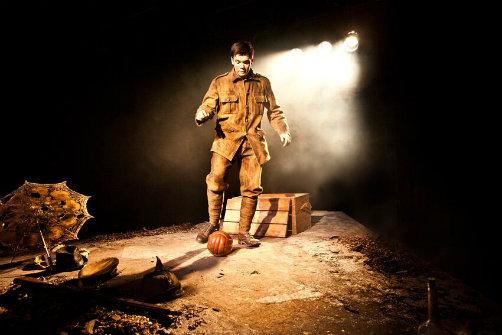
Our Friends The Enemy: The 1914 Christmas Truce
Written and Performed by Alex Gwyther; Directed by Tom O’Brien
Presented by David Adkin
Off Broadway, New Solo Show
Runs through 12.20.15
Theatre Row's Lion Theatre, 410 West 42nd Street
by Shani R. Friedman on 12.14.15
 Alex Gwyther in Our Friends The Enemy. Photo by Pamela Raith.
Alex Gwyther in Our Friends The Enemy. Photo by Pamela Raith.
BOTTOM LINE: The brutalities of war, and the power of brotherhood and the Christmas spirit to achieve peace, are given vivid life in this moving one-man show.
The true story of the brief truce during the first Christmas of World War I is one that’s known to probably just about every person in the United Kingdom. No less than Prince William, who “grew up with the story of soldiers putting down their arms… on Christmas Day,” has heard about this remarkable moment a century ago. Americans too have perhaps learned of the soccer (football) game that took place between the Allied and German soldiers on the Western Front, although there is much more to the history than the mere sporting event.
Gwyther plays Private James Boyce, who is fighting for Queen and country alongside his school friend George. He keeps a diary and writes letters to his mum. Boyce, like many of those on the battlefield, is probably still a teenager, or at most barely 20. It’s December 10th, 1914; the war has been underway for nearly six months. Two of the most important things in his life are his mother and God: a prayer is the first line of dialogue as Boyce is thrown to the ground by enemy fire ahead. There are also small pleasures like the new socks his mother has sent, and bacon, of which Boyce says, “Despite…the stench of death and a lingering sense that it could be your final hour, I’ve never tasted bacon so good as I have done sitting in a hole in the ground.” Boyce and George talk about school to remind them of the world beyond the trenches, he writes, and also mentions the daily happenings, like the healthy new men joining them and the stockpile of liqueur George has found. Gwyther, aided by just a handful of props, brings a lovely gentleness to the part, but is also playful, funny and poignant.
Gwyther inhabits other British, German and Scottish soldiers as well, who are fighting in St. Yves, Armentieres and across Europe. Curiously, Gwyther doesn’t do a German accent, but perhaps as a Welshman he decided to stick with ones closer to home. The soldiers in St. Yves joyously take out the contents of a crate that contains cigarettes, bacon, and a football. German soldiers in another hole have discovered a fern in the forest that fills them with childhood memories of Christmas as they excitedly decorate it with candles. As Gwyther jumps from person to person and city to city, he’s guided by the effective lighting and sound design (by Derek Anderson and David Gregory, respectively) that transport the action from the quiet moments in the trenches and woods to ones where the sky is lit up from bombs, and to the lively, celebratory scenes during the ceasefire.
On Christmas Eve, Boyce comes upon two German soldiers who plead with him not to shoot. Thinking of George, who is missing and presumed dead or captured, he raises his rifle but “away from the front…I didn’t have it in me.” Instead they chat and agree to meet some days later. Elsewhere, a German soldier tosses a rock into an Allied trench with a note around it containing the message “Merry Christmas Englishmen.” On Christmas Day, the soldiers in the various regiments awake to quiet, some calling out Christmas greetings, offering cigarettes or just standing about, everyone unsure of what would come next. In La Touquet the sides exchange gifts and addresses. In St. Yves the soldiers kick around a ball in the infamous game until their Commanders order them to stop. In Frelinghien, the two sides pose for a photo, a “testimony of their disobedience and proof of our Christmas Day.” As Boyce writes his mother on Boxing Day, telling her of the British and Germans coming together to help bury the dead, “The Christmas spirit seems to have a place even in the darkest of corners.”
Of course peace would not last, and as Gwyther and O’Brien pointed out in the talk back afterward, the strategies behind the war changed to become more aggressive, and weapons such as gassing were used on the enemy for the first time. Gwyther said there were a few historical mentions of such gestures happening in 1915, but it was still vastly different from today's warfare. Certainly, had such modern weapons been used, it would not have been possible for the two sides to continue seeing each other as “fighting the same enemy, just on two different sides,” as a German soldier said to Boyce while helping him bury George. It’s not a long show, but it packs a thoughtful and emotional punch. Gwyther and O’Brien have crafted a show that, 100 years later, feels very relevant this holiday season, with women and men in harm’s way in conflicts around the world.
(Our Friends The Enemy: The 1914 Christmas Truce plays at Theatre Row's Lion Theatre, 410 West 42nd Street, through December 20, 2015. The show runs approximately 60 minutes with no intermission. Performances are Tuesday at 7, Wednesday through Friday at 8, Saturday at 2 and 8, and Sunday at 3. Tickets are $36.25 and available by visiting www.ourfriendstheenemy.com or by calling 212.239.6200.)
Our Friends The Enemy: The 1914 Christmas Truce is written and performed by Alex Gwyther and directed by Tom O’Brien. It is Presented by David Adkin. Scenic Design is by James Hirst. Lighting Design is by David Goldstein. Sound Design is by David Gregory. The Composer is Darren Clark. Vocal Coach is Maeve Diamond.

